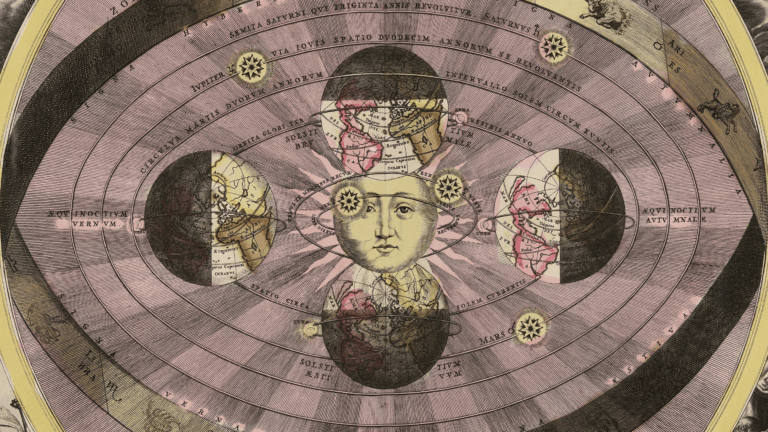
CORE 103: The Process of Change in Science
CORE 103: The Process of Change in Science seeks to destabilize the prevailing notion of the scientific as immutable and without agenda. Instead, students are tasked with thinking critically about science in its many sociocultural, historical, and political contexts with an eye towards parsing scientific discoveries and the narratives we derive from them.
CORE 101, 103, and 104 may be taken in any order, in any semester. Students are encouraged to take courses when a particular iteration speaks to their interests.
Sample Classes
T.O. faculty are tasked with iterating variations on the CORE 103 theme, The Process of Change in Science. Accordingly, there are as many versions of CORE 103 as there are professors who teach it. Here are just a few recent examples.

Human Exploration and Settlement
of the Solar System
Professor Vahé Peroomian, Department of Physics & Astronomy
Two centuries ago, it was “common wisdom” that all of the planets of the Solar System were inhabited and were each home to flourishing civilizations. Percival Lowell’s imagined observations of Martian canals in the waning years of the nineteenth century further fueled this belief. Since 1965, when the Mariner 4 spacecraft found Mars to be a lifeless, barren world, our imagination has taken a new turn—that of terraforming Mars and making it habitable for humans. More recently, both science and science fiction have considered the possibility of human settlement throughout the Solar System, not just on Mars but also in the seemingly inhospitable outer Solar System.
In this course, we will consider the eventual human exploration and settlement of the Solar System not just from a scientific and technological standpoint, but also by examining the interdependencies of complex systems and the human and societal aspects of this endeavor. We will first familiarize ourselves with the Solar System, exploring not only the planets, but also the Asteroid Belt and many of the larger moons of Jupiter and Saturn. Each of these destinations will offer unique challenges to human habitability, some of which may not be immediately apparent.
Science fiction authors have imagined human exploration and settlement of the Solar System and other star systems for centuries. Ray Bradbury’s whimsical The Martian Chronicles continued the narrative of a dying Martian civilization popularized by Edgar Rice Burroughs’ Barsoom series. Nearly a century later, Kim Stanley Robinson’s Red Mars gave us one of the most thoughtful considerations of settling and terraforming Mars, and his 2312 imagined a Solar System teeming with humanity. In James S. A. Corey’s Expanse series, Earth and Mars are superpowers vying for the resources of the Solar System. An exploration of these and other science fiction works will supply out-of-the-box thinking for many of the Solar System destinations we visited (and perhaps dismissed).
The keystone for this course will be a group project in which students will design their own human settlement, within the Solar System but otherwise only bound by their imagination and research. This project will go beyond a simple world building exercise and will include details of societal interactions, familial considerations, laws, individual rights, and government.
Texts
- Ray Bradbury. The Martian Chronicles.
- Edgar Rice Burroughs. A Princess of Mars.
- James S.A. Corey. Leviathan Wakes.
- Romulus-Catalin Damaceanu. Solar System Colonization (Outer Space Conquering).
- Michio Kaku. The Future of Humanity: Terraforming Mars, Interstellar Travel, Immortality, and Our Destiny Beyond Earth.
- National Research Council. Scientific Opportunities in the Human Exploration of Space.
- —. The Human Exploration of Space.
- Kim Stanley Robinson. Red Mars.
- —. 2312.
- Robert Zubrin. The Case for Mars: The Plan to Settle the Red Planet and Why We Must.

Revolution and Evolution of Ideas
Professor Donal Manahan, Department of Biological Sciences
Science (understanding nature) and technology (manipulating nature) are dominant themes influencing our society. Modern science is viewed as a logical approach to understanding nature and our place in the universe. Throughout the history of thought, however, the word “science” had a much broader meaning, with the word dating back to Latin origins that describe a process that produces basic knowledge in any field. The invention of writing led to general access to books and peer reviewed journals. This advance was central to the documentation of progress in knowledge that, over centuries, led to the acceptance of new ideas regarding how our world works. These new ideas were sometimes accepted quite rapidly, but often there was a slower acceptance.
The revolution and evolution of new ideas is a central theme of this course. We will explore the historical development of revolutions in thinking in fields ranging from biology, chemistry, geology, medicine, and physics. Historical and modern literature will be explored, with opportunities for students to have in-person access to “Great Books” in science (rare books, in particular). There will also be a focus on the biographies of “Great Thinkers” in the history of scientific knowledge, spanning earlier to modern times.
In the latter part of the course, current societal issues will be discussed regarding the concept of “misinformation” in matters of science and technology related to human health, environmental change, disease prevention, food and energy policies, applications of artificial intelligence, and other emerging topics. Student engagement will be actively encouraged in the selection of these specific topics for in-depth review and discussion.
Texts
- Brian Clegg. Scientifica Historica: How the World’s Great Science Books Chart the History of Knowledge.
- Additional readings distributed during class.

Science, Arms, and the State
Professor Peter Westwick, Thematic Option Honors Program and Van Hunnick Department of History
This seminar examines the enlistment of science and engineering in the development of military technology, focusing especially on weapons of mass destruction—chemical, nuclear, and biological—in the twentieth century. From the gas-choked Western Front in World War I to the radioactive ruin of Hiroshima and the anthrax scare after 9/11, science-based weapons have introduced new terrors to warfare but also raised hopes that there are limits to what humankind might deploy in combat. The course will examine the interplay of science, policy, and strategy in various episodes and national contexts, and in the process will raise some basic questions: Why have scientists, whose profession aims to increase knowledge of the natural world, worked to devise new ways to wage war? How have scientists justified working on military problems? How did their inventions change the nature of warfare? Do certain weapons entail special moral judgments? Why are some technologies accepted for use in combat and others are not? How has military patronage influenced the direction and character of science? Has it changed the type of research problems scientists pursue, the way they approach those problems, or the evolution of scientific disciplines and institutions? What were the effects of military secrecy and classification on the scientific community, and on the state? Have particular states or political ideologies differed in their support of weapons research? How has democracy accommodated the need for elite scientific expertise? Why do some states pursue advanced weapons and others forego them? How did public and political movements for arms control arise? Were they effective?
Texts
- Hugh Gusterson. Nuclear Rites: A Weapons Laboratory at the End of the Cold War.
- Robert Harris and Jeremy Paxman. A Higher Form of Killing: The Secret History of Chemical and Biological Warfare.
- Sven Lindqvist. A History of Bombing.
- Richard Rhodes. The Making of the Atomic Bomb.
- Scott D. Sagan and Kenneth N. Waltz. The Spread of Nuclear Weapons: An Enduring Debate.

